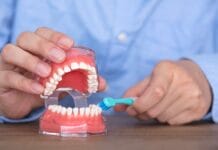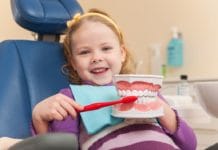Trauma is a word that gets thrown around in our culture without much investigation into its true meaning or impact. I have heard people say they have post-traumatic stress disorder (PTSD) from events such as writing a research paper in dental hygiene school, a former drama-filled dental office, a television show, and food that does not agree with their sensitive constitution.
As a mental health professional, these statements leave me concerned for those who have PTSD. Was hygiene school stressful, and did it leave me with lingering negative ideas and effects? Yes, but was it detrimental to my lifelong well-being or life-threatening? No! I am concerned that if we rank it within the same category as a rigorous oral pathology instructor, those who suffer will get overlooked or dismissed. The language diminishes the lived experiences of those who carry the legitimate burden of PTSD. Actual traumatic events can significantly affect individuals’ lives and can be debilitating.
Many patients in our dental chairs have suffered traumatic events that impact daily life. As a dental professional, it is vital to have a basic understanding of trauma and how it weaves its immobilizing web into people’s lives.
What Is Trauma?
According to the Substance Abuse and Mental Health Administration, trauma is an event or series of events experienced as physically or emotionally detrimental or life-threatening. These experiences have enduring consequences on the individual’s mental, physical, social, emotional, or spiritual well-being.1
The “Three Es” of trauma include events, experiences, and effects.2
Events
A person suffering from ongoing trauma must have experienced or been exposed to an event or series of emotionally distressing events. These events include but are not limited to violence, abuse (physical, sexual, mental, or emotional), war, accidents, natural disasters, loss, and life-threatening neglect. The magnitude of the events is disturbing or upsetting to the individual and interferes with daily function.2
Experience
The way each person experiences an event can vary. For example, if you and I get in a car accident together, you may recover immediately, feeling thankful that we were not hurt. You may say, “But Kandice, we walked away. We are fine.” In the meantime, I may suffer from nightmares and cannot bring myself to get back behind the wheel.
The way you experienced and processed the event is different than my experience. This has to do with the way the brain processes and imprints information from the event(s). Brain scans show a correlation between how information is processed through the limbic system, visual cortex, and Broca’s area (linked to speech production) and how the brain reacts under duress when the event is recalled. Various other influences include a person’s past trauma exposure, the event’s nature, access to immediate treatment, and sociocultural considerations.3 Therefore, assuming that someone’s experiences are identical can leave us misinterpreting what they are going through.2
Effects
Effects of the traumatic event(s) can be immediate, such as ongoing nightmares or immobilizing thoughts and feelings. The effects can surface as dysfunctional behaviors such as alcohol/drug abuse and reckless behavior persistently interfering with an individual’s daily function. Effects can surface or be “triggered” in the dental chair.2
Neurobiology of Trauma
A traumatic event(s) can severely impact the brain and how it responds to the environment. When we experience a “normal” or nontraumatic event (even if upsetting or stressful), we process it through our brain’s logical centers. We might look back on that event and recall the event and feelings around it. The emotions may be positive or negative, but we can remember them with little or no emotional distress.
A traumatic memory is not a memory at all. It is an experience stored in the brain’s emotional centers that live on as the event’s original images, feelings, and sounds. These sensations engulf the person triggered and simulate a “reliving” of the experience. This can leave the person confused, exhausted, and fearful.4
These triggers can explain irrational or exaggerated behaviors from patients in the dental chair, such as yelling, crying, or turning the head away from a simple stimulus like a mouth mirror. The stimuli or trigger for the trauma can be generalized, meaning it only resembles the original trauma. Triggers or stimuli can be in the form of sights, sounds, smells, language, feeling out of control, and various other retraumatizing instances.
Our patient may have the engulfing feelings of the original trauma surface without realizing it is even connected to their event(s). It may be induced by a mirror in their mouth, laying back in the chair, and feeling powerless in the patient’s position.5
Earlier, I stated that we do not get PTSD from events that are not truly traumatic, such as dental hygiene school. Here is where it gets complicated. Someone with previous trauma may get stuck in the flight or fight response, and the slightest stress can become an emergency.
Everyday circumstances that require emotional regulation or resilience may surface as feelings of the trauma. Because of past trauma, the person lives in a state of flight or fight, causing the internal smoke alarms to sound frequently. This may surface as a variety of behaviors, such as defensiveness, severe anxiety, and loss of control.3
The depth of this topic goes far deeper than the scope of this article. Therefore, if this sounds like you or someone you love, I encourage reaching out to a therapist who is trained in trauma to dig into how past experiences may be affecting the brain’s ability to process current information.
Clinical Signs of Retraumatization in the Dental Chair
Retraumatization is defined as creating (either purposefully or inadvertently) a situation that mimics the patient’s original trauma. Again, this can be placing something in their mouth before they are ready, laying them back in the chair, talking down to or over them, or being insensitive to their needs. These are general stimuli that trigger the emotional center of the brain where the trauma lives.3
The patient can then re-experience the trauma without realizing the connection. This can lead to anger, fear, anxiety, being flat (showing no emotion or expression), being submissive, or lacking trust in the provider.3 To the hygienist, this may seem like run-of-the-mill dental anxiety. This can be frustrating for the clinician as we label this patient as “difficult” or “uncooperative.” To the patient, this could feel like a life-or-death moment, and the behavior that arises feels out of their control.
Pausing to consider the underlying roots of the behavior helps us align with empathy for the patient. This can help us work through the situation and build trust and resilience for the patient.
Pity, Sympathy, Empathy, and Toxic Positivity
I often see the difference between pity, sympathy, empathy, and toxic positivity confused.
Pity says, “Oh no! You poor thing. You are so nervous.” When we are not careful, sympathy can come across as condescending or like pity. This can be as “I am sad that you have dental anxiety.”
Empathy meets the patient where they are when we put ourselves in their shoes. As empathetic clinicians, we try our best to see it through their eyes and consider that an experience may bring up current feelings. In this instance, we can use reflective statements and ask the patient what we can do to support them through the appointment.
Then there is toxic positivity. The use of toxic positivity is almost always an innocent attempt at helping a person feel better. Still, it results in a dismissive and shaming outlook of the patient’s emotions, thoughts, and lived experiences. Toxic positivity tells someone going through a retraumatizing event to “just be positive.” It is a “look on the bright side” type of attitude. If you could see the positive things in your life, know that everything happens for a reason, and choose happiness, you would feel much better. Let me make you laugh, and all will be OK!6
It does not work this way for a person with trauma or PTSD. The reliving of the trauma is very real to them, and trying to convince them that being happier or more positive will give them the strength to do some good old-fashioned bootstrap pulling is dismissive and leaves them feeling judged. The person with trauma does not choose to feel this way. They are struggling with a brain-wiring issue.6
Approaching and Communicating with the Traumatized Patient
As we assess our patient’s possible exposure to a traumatic event, it is nearly impossible to conclude which individuals have endured trauma. We can know the clinical signs or clues in the patient’s health history. We may never know what events, experiences, or effects leave our patients with unexplained dental fear or certain behaviors in the dental chair.
If we proceed with each appointment as trauma-informed care clinicians, we can significantly reduce or eliminate the traumatic response for patients.
Trauma-informed care is a complex process that allows the clinician to view their patient population broadly. This lens reminds the provider that trauma is widespread and that every person who sits in the dental chair may have trauma that can be triggered during the appointment.
It’s is crucial to remember the underlying cause of someone’s behavior can be trauma-related, and PTSD is caused by significant events that leave pervasive effects. Most of all, turn your judgment into curiosity, proceed with empathy, and never take it personally.
Before you leave, check out the Today’s RDH self-study CE courses. All courses are peer-reviewed and non-sponsored to focus solely on pure education. Click here now.
Listen to the Today’s RDH Dental Hygiene Podcast Below:
References
- Trauma and Violence. (2024, November 8). Substance Abuse and Mental Health Services Administration. https://www.samhsa.gov/trauma-violence
- Practical Guide for Implementing a Trauma-Informed Approach [SAMHSA Publication No. PEP23-06-05-005]. (2023). Substance Abuse and Mental Health Services Administration. https://library.samhsa.gov/sites/default/files/pep23-06-05-005.pdf
- van der Kolk, B. (2014). The Body Keeps the Score: Brain, Mind, and Body in the Healing of Trauma (pp. 39-47). Penguin Books.
- Boccia, M., D’Amico, S., Bianchini F., et al. Different Neural Modifications Underpin PTSD after Different Traumatic Events: An fMRI Meta-analytic Study. Brain Imaging Behav. 2015; 10(1): 226-237. DOI:10.1007/s11682-015-9387-3
- Comer, R.J., Comer, J.S. Abnormal Psychology (11th ed.). (2021). Worth Publishers.
- Cherry, K. (2024, May 14). Why Toxic Positivity Can Be Harmful. Verywell Mind. https://www.verywellmind.com/what-is-toxic-positivity-5093958












